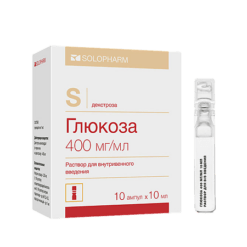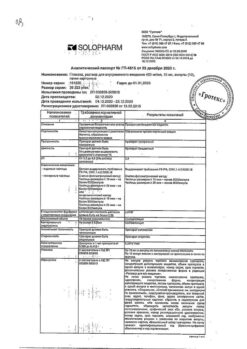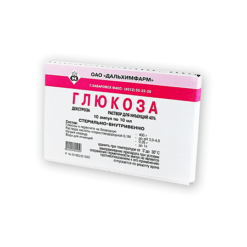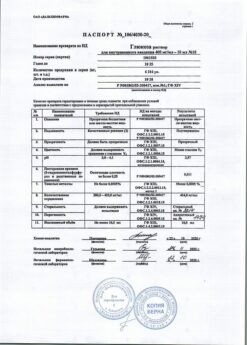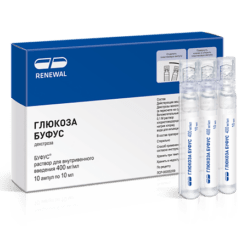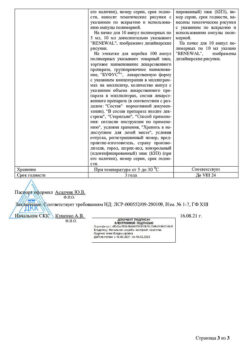No products in the cart.
Glucose, 5% 250 ml
€0.88 €0.73
Out of stock
(E-mail when Stock is available)
Description
Pharmgroup:
Feeding carbohydrate agent.
Pharmic Action:
Participates in various metabolic processes in the body.
The infusion of dextrose solutions partially replenishes the water deficit. On entering the tissues dextrose is phosphorylated into glucose-6-phosphate, which is actively involved in many parts of the body’s metabolism.
The 5% solution of dextrose is isotonic to blood plasma. Hypertonic solutions (10%, 20%, 40%) increase osmotic blood pressure, increase diuresis. The theoretical osmolarity of 10% dextrose is 555 mOsm/L, 20% – 1110 mOsm/L.
Pharmacokinetics:
Is fully absorbed by the body, is not excreted by the kidneys (the appearance in the urine is a pathological sign).
Indications
Indications
Hypoglycemia, carbohydrate deficiency, toxic infection, intoxication due to liver diseases (hepatitis, liver dystrophy and atrophy, including liver failure), hemorrhagic diathesis; dehydration (vomiting, diarrhea, postoperative period); intoxication; collapse, shock.
As a component of various blood replacement and anti-shock fluids; for the preparation of drug solutions for intravenous administration.
Pharmacological effect
Pharmacological effect
Pharmaceutical group:
nutritional carbohydrate remedy.
Pharmaceutical action:
Participates in various metabolic processes in the body.
Infusion of dextrose solutions partially compensates for the water deficiency. Dextrose, entering the tissues, is phosphorylated, turning into glucose-6-phosphate, which is actively involved in many parts of the body’s metabolism.
A 5% dextrose solution is isotonic to blood plasma. Hypertonic solutions (10%, 20%, 40%) increase the osmotic pressure of the blood and increase diuresis. The theoretical osmolarity of 10% dextrose is 555 mOsm/l, 20% is 1110 mOsm/l.
Pharmacokinetics:
It is completely absorbed by the body and is not excreted by the kidneys (appearance in urine is a pathological sign).
Special instructions
Special instructions
For more complete and rapid absorption of dextrose, you can administer 4-5 units of short-acting insulin subcutaneously, at the rate of 1 unit of short-acting insulin per 4-5 g of dextrose.
Active ingredient
Active ingredient
Dextrose
Contraindications
Contraindications
Hypersensitivity, hyperglycemia, hyperlacticacidemia, hyperhydration, postoperative disorders of glucose utilization; circulatory disorders that threaten cerebral and pulmonary edema; cerebral edema, pulmonary edema, acute left ventricular failure, hyperosmolar coma, childhood (for solutions over 20-25%).
With caution. Decompensated CHF, chronic renal failure (oligo-, anuria), hyponatremia, diabetes mellitus.
Side Effects
Side Effects
Hypervolemia, acute left ventricular failure.
At the injection site – the development of infection, thrombophlebitis.
Interaction
Interaction
When combined with other drugs, it is necessary to control pharmaceutical compatibility, incl. visually.
Overdose
Overdose
Symptoms: hyperglycemia, glycosuria, hyperglycemic hyperosmolar coma, hyperhydration, water-electrolyte imbalance, increased liponeogenesis with increased production of CO2, which leads to a sharp increase in minute tidal volume, and, as a consequence, respiratory rate; fatty infiltration of the liver.
Treatment: stop administering glucose, administer insulin, symptomatic therapy.
Storage conditions
Storage conditions
The drug should be stored out of the reach of children at a temperature not exceeding 2-8°C.
Shelf life
Shelf life
3 years
Manufacturer
Manufacturer
Medpolymer, Russia
Additional information
| Shelf life | 3 years |
|---|---|
| Conditions of storage | The drug should be kept out of reach of children at temperatures not exceeding 2-8°C. |
| Manufacturer | Medpolymer, Russia |
| Medication form | solution for infusion |
| Brand | Medpolymer |
Other forms…
Related products
Buy Glucose, 5% 250 ml with delivery to USA, UK, Europe and over 120 other countries.


